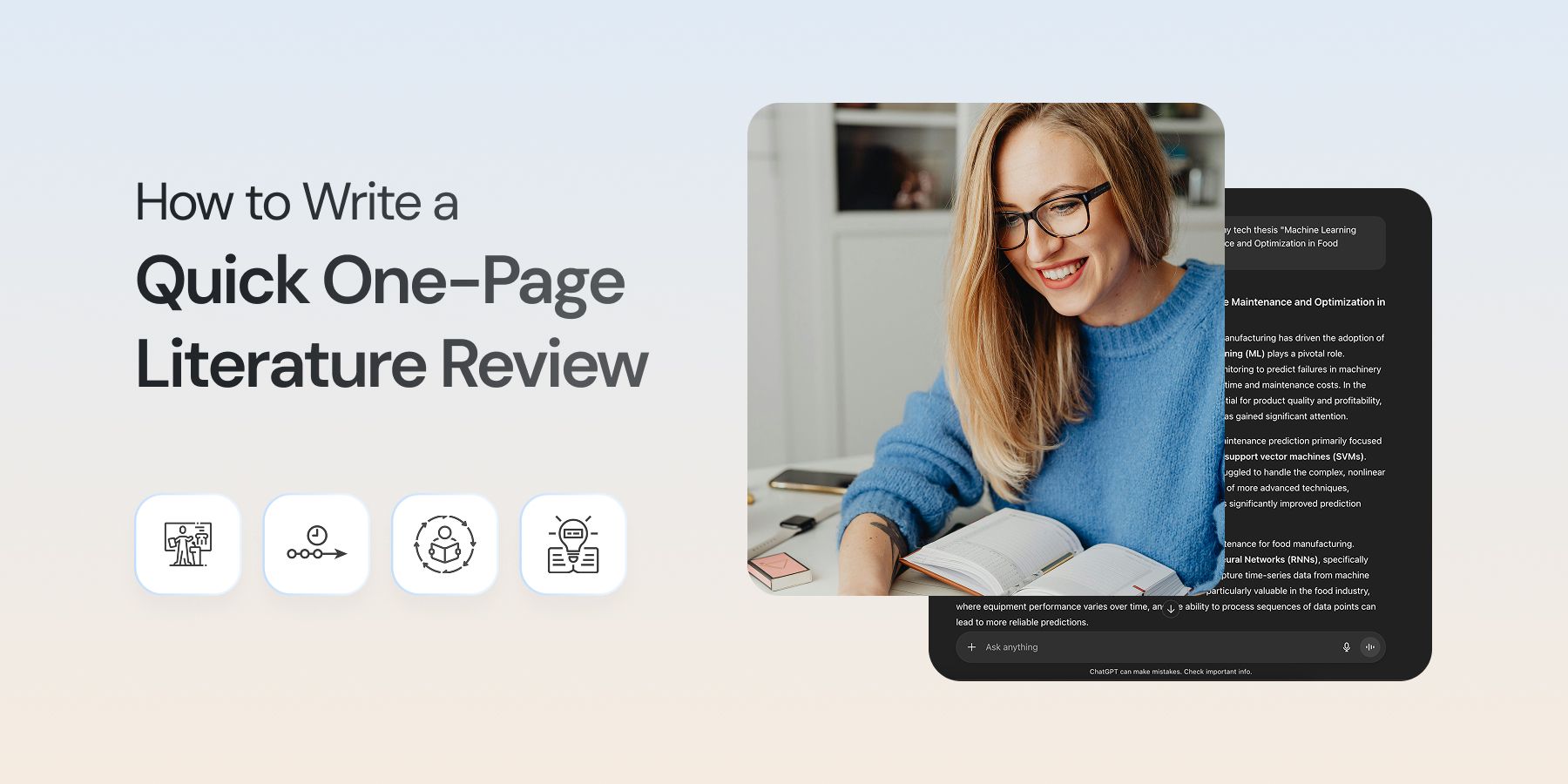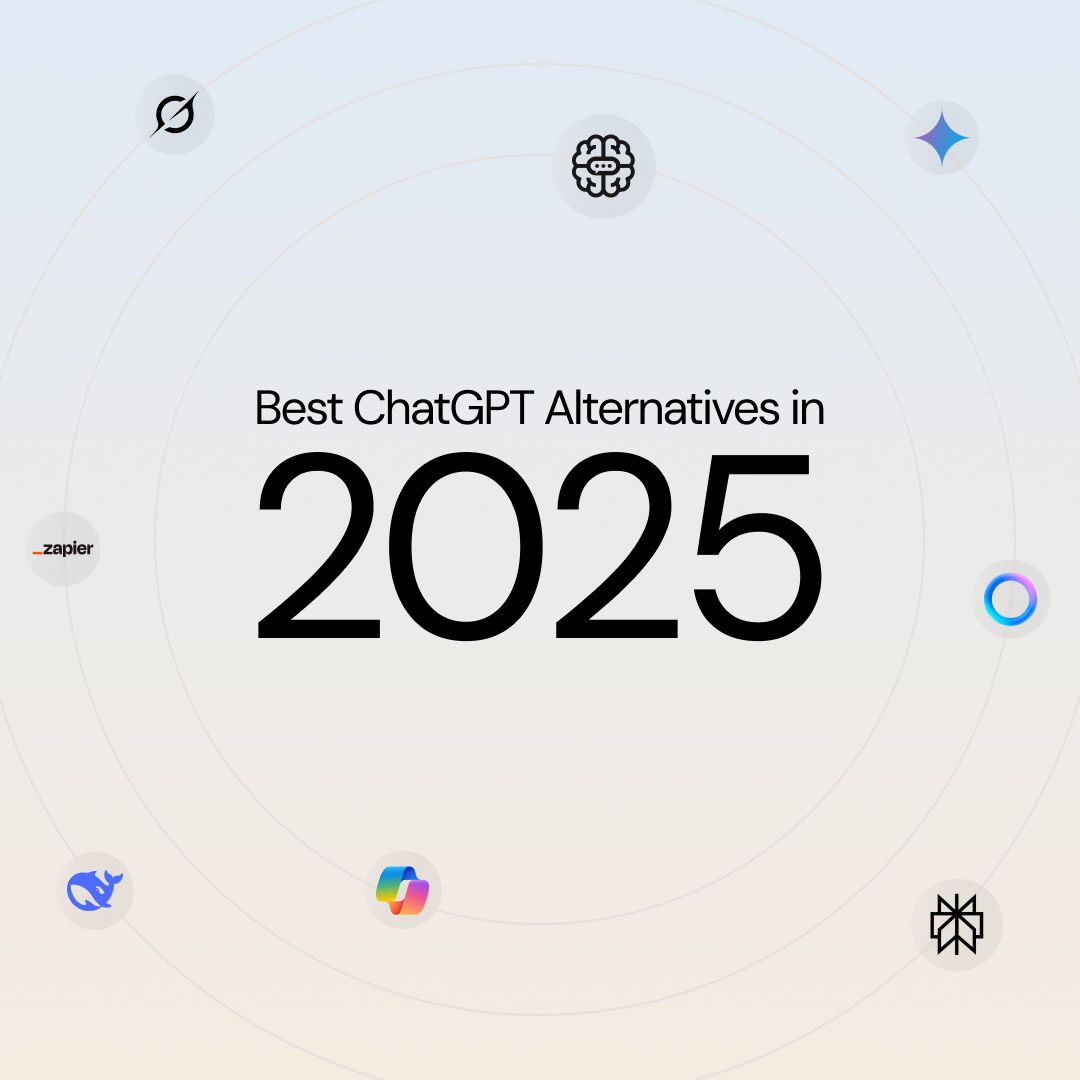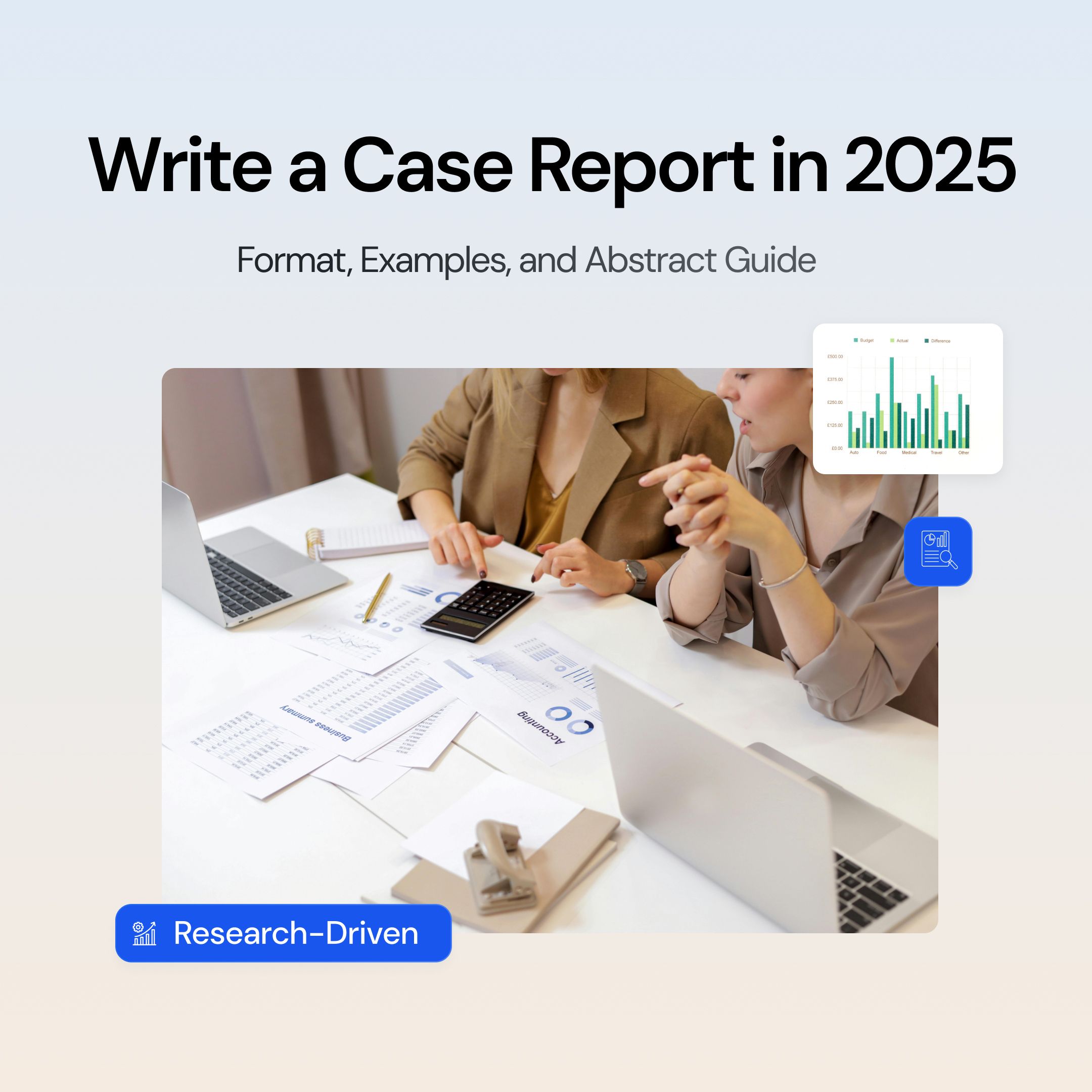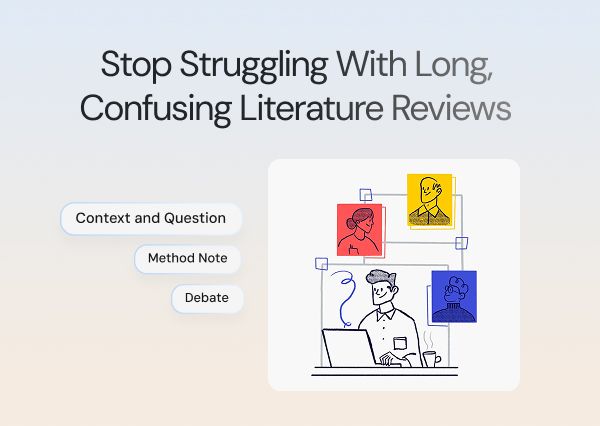
How to Write a Quick One-Page Literature Review
When time is tight and space is limited, a well-crafted one-page literature review can be your secret weapon. This can be done through modern tools like AI Chat, AI search, that can cut down the overall time spent significantly.
Whether you're writing a research proposal, preparing a brief for stakeholders, or conducting preliminary research, the ability to synthesize existing knowledge into a single, focused page is an invaluable skill that demonstrates both depth of understanding and clarity of thought.
The one-page format forces you to be precise, strategic, and selective, qualities that actually improve the overall quality of your review.
By eliminating unnecessary padding and focusing on the most critical insights, you create a document that's both comprehensive enough to demonstrate scholarly rigor and concise enough to hold your reader's attention from start to finish.
What is a Literature Review in Research
A literature review serves as the intellectual foundation of your research, systematically examining existing scholarship to identify what's known, what's contested, and what remains unexplored.
For your audience, whether professors, funding committees, or fellow researchers, it demonstrates your command of the field and positions your work within the broader scholarly conversation.
The primary outcomes of an effective literature review include establishing theoretical frameworks, revealing methodological approaches, identifying research gaps, and providing the rationale for your proposed study.
When writing a literature review, you're not just summarizing sources, instead you're creating a narrative that connects disparate findings into a coherent understanding of your research domain.
Many say that ChatGPT is a great tool that can aid in performing these tasks, and this is not wrong. But if you are looking to employ modern technology to write a literature review in research, there are multiple ChatGPT alternatives that you can explore to save your time and cost.
Key Pointers Related to Writing a Quick One-Page Literature Review
-
Researchers spend 25–50% of their work time writing and synthesizing review content.
-
In 2020, peer reviewers logged 130 million hours reviewing manuscripts across journals worldwide.
-
Literature reviews often take 20–40% of total paper length, showing their weight in research writing.
-
Review articles are starting points for many PhD projects, guiding research direction and focus.
-
A strong review follows three clear steps – screening, extraction, and writing – for workflow discipline.
When a One-Page Format is the Right Choice
It's particularly valuable when writing for busy decision-makers who need essential information without extensive detail.
However, compression isn't always appropriate. Comprehensive dissertations, systematic reviews, and detailed grant applications typically require extended literature reviews that can fully explore methodological nuances and theoretical complexities.
The key is matching format to function, use one page when your goal is strategic overview rather than exhaustive coverage. You can also explore the best AI writing tools for any specific solutions too.
What Goes into a Literature Review
Every literature review, regardless of length, must include seven essential elements. These include a focused research question, clearly defined scope, brief methodological note, identification of key themes, acknowledgment of tensions or debates, articulation of the research gap, and implications for future work.
These components work together to create a complete picture of the current state of knowledge in your area. The research part, specifically, for a literature review can be handled through AI search, where it brings you top studies and research papers as needed.
How to Structure a Literature Review
The structure of a literature review should follow a logical framework that guides readers through your analysis. Rather than simply listing studies chronologically, organize your content around meaningful patterns that emerge from the literature.
Your chosen framework becomes the skeleton that holds your synthesis together, making complex information accessible and actionable. AI tools like AI chat can greatly assist you in structuring your content better and formatting it more logically.
Pick Your Frame – Four Workable Patterns
There can be multiple frames that you can pick to effectively write a literature review.
Thematic
Organize studies around key mechanisms, outcomes, or concepts that emerge from your analysis. This approach works well when research clusters around distinct topics or when you want to highlight different aspects of a complex phenomenon. Group studies that examine similar variables or theoretical constructs, then compare their findings within each theme.
Chronological
Use temporal organization when knowledge has evolved significantly over time or when historical context is crucial for understanding current debates. This frame helps readers see how thinking has shifted, what questions have persisted, and how methodological improvements have changed what we can know about your topic.
Methodological
Compare studies based on their research designs, data collection methods, or analytical approaches. This frame is particularly useful when methodological differences might explain conflicting findings or when you want to highlight the strengths and limitations of different approaches to studying your phenomenon.
Theoretical
Contrast competing theories, models, or frameworks that make different predictions about your research area. This approach works well when the field is characterized by theoretical debates or when you want to position your work within a particular theoretical tradition while acknowledging alternative perspectives.
Define the Question and Scope
Transform your broad topic into a precise, answerable question that will guide your entire review process.
Instead of asking "What do we know about student motivation?" ask "How do intrinsic and extrinsic motivational factors influence academic performance in undergraduate STEM courses?" This specificity helps you make strategic decisions about what to include.
Establish clear boundaries around dates (studies from the past decade), population (undergraduate students), setting (STEM courses), and methodology (quantitative and mixed-methods studies).
These parameters prevent scope creep while ensuring your review remains focused and manageable within the one-page constraint.
Build a Focused Search Strategy
Start with 2-3 major databases relevant to your field, then develop synonym clusters for your key concepts. If studying "student engagement," also search for "academic involvement," "classroom participation," and "learning motivation."
Use simple Boolean operators (AND, OR) rather than complex search strings that might miss relevant studies.
Keep a search log documenting your databases, search terms, and results. This transparency supports replication and helps you refine your strategy when initial searches yield too many or too few relevant sources. When writing a literature review under tight constraints, a systematic approach to searching saves precious time during the screening phase.
Screen and Select Sources Quickly
Develop a two-stage screening process. First, scan titles and abstracts to eliminate obviously irrelevant studies. Second, apply stricter inclusion criteria to abstracts that pass initial screening. Create simple yes/no rules based on your scope parameters, studies must address your population, use acceptable methods, and contribute meaningful findings.
Recognize your saturation point, the moment when additional sources repeat themes you've already captured rather than adding new insights. For a one-page review, 12-20 high-quality sources typically provide sufficient coverage while remaining manageable for detailed analysis.
Extract Notes with a Compact Table
Create a six-column extraction table with headers containing Citation, Context, Method, Sample, Finding, Limitation. This systematic approach ensures you capture essential information while maintaining consistency across sources.
Keep entries brief but specific, note sample sizes, key variables, and effect sizes rather than general descriptions.
This structured extraction serves two purposes mainly. It speeds up the synthesis process by organizing information consistently, and it helps you identify patterns more easily when you're ready to write. The table becomes your raw material for creating the thematic groupings that will structure your final review.
Synthesis Moves that Fit One Page
Effective synthesis goes beyond summarization to create new understanding through comparison and analysis. Compare findings across studies to identify consistent patterns, then explain why divergent results might occur, different populations, methods, or contexts often account for conflicting conclusions.
Show trends and exceptions by highlighting both mainstream findings and outlier studies that challenge conventional wisdom. These exceptions often point toward important boundary conditions or moderating variables that future research should explore.
Use phrases like "while most studies find..." followed by "however, two studies suggest..." to acknowledge complexity without losing focus.
Name the specific gap your research will address, connecting it directly to the patterns and tensions you've identified.
Rather than claiming "more research is needed," specify exactly what type of research would advance understanding, particular populations, methods, or theoretical approaches that remain unexplored.
Literature Review Format
Structure your one-page review in six logical sections. These sections will be research question and context, scope and search methodology, first major theme, second major theme, key tensions or debates, and conclusion with research implications. This format ensures comprehensive coverage while maintaining readability and flow.
Literature Review Format Example
Here are a few literature review format examples.
Context and Question: Research on remote work productivity has proliferated since 2020, yet findings remain inconsistent across organizational contexts. This review examines how individual and organizational factors influence productivity outcomes in remote work arrangements.
Method Note: We searched PsycINFO, Business Source Premier, and Google Scholar for peer-reviewed studies published 2020-2024, using terms "remote work," "telecommuting," and "productivity." Fifteen studies met inclusion criteria of quantitative measurement and organizational samples.
Theme One - Individual Factors: Seven studies consistently show that employee self-regulation skills predict remote work productivity (r = .42-.58). Workers with strong time management, goal-setting, and self-monitoring capabilities maintain or increase output when working remotely, while those lacking these skills show 15-25% productivity declines.
Theme Two - Organizational Support: Six studies demonstrate that organizational factors significantly moderate individual effects. Companies providing structured communication protocols, regular check-ins, and appropriate technology support see positive productivity outcomes regardless of individual self-regulation scores, suggesting organizational design can compensate for individual limitations.
Debate: Studies conflict on whether remote work benefits creativity and innovation. Three studies report decreased creative output due to reduced informal interaction, while two studies find increased innovation when remote workers have dedicated collaboration time and tools.
Conclusion: Remote work productivity depends on the interaction between individual capabilities and organizational support systems. Future research should examine how specific organizational interventions can develop self-regulation skills and whether hybrid models optimize both productivity and creativity outcomes.
How to Do a Literature Review for a Research Paper
When conducting a literature review for a research paper, anchor your analysis to the specific variables and measures you plan to use in your own study. If you're measuring academic achievement through GPA, prioritize studies that use similar outcome measures rather than those using standardized test scores or subjective evaluations.
Link your literature review directly to your research design by highlighting methodological approaches that inform your choices. If you're planning a longitudinal study, emphasize what longitudinal research has revealed that cross-sectional studies missed, justifying your methodological decisions through the literature.
How to Write a Scientific Literature Review
Scientific literature reviews emphasize methodological rigor and quality signals that help readers evaluate the strength of existing evidence. Prioritize studies with appropriate control groups, adequate sample sizes, replication across contexts, and transparent data access policies.
When synthesizing scientific literature, focus on effect sizes, confidence intervals, and statistical power rather than just significance levels. Highlight methodological innovations and identify where replication studies confirm or challenge original findings, building a foundation for evidence-based conclusions.
Citations and References on a Single Page
Use a streamlined in-text citation style, author-date format works well for one-page reviews. Aim for 12-20 citations to demonstrate adequate coverage without overwhelming your limited space. Create a compact reference list using hanging indents and abbreviated journal names to maximize space efficiency.
Common Mistakes and Quick Fixes
The most common mistake in one-page literature reviews is creating lists of studies without synthesis, summarizing each source individually rather than integrating findings around themes. Fix this by grouping studies before writing and focusing on patterns rather than individual contributions.
Avoid overusing review articles at the expense of primary research. While reviews can provide helpful context, your analysis should primarily synthesize original studies to demonstrate direct engagement with the research base. Similarly, resist theory bloat, include the theoretical framework only when it directly supports your analysis.
Update your source base regularly, as one-page reviews require current, relevant literature. Five-year-old studies may still be valuable, but they shouldn't dominate a review meant to capture the current state of knowledge. Finally, vague scope statements like "this review examines workplace issues" doom your project from the start, precision in scope enables effective synthesis.
Speed Workflow: Forty-Five Minutes
To speed up the workflow in a limited time, here’s what you can do.
Allocate your time strategically to extract the maximum value out of it. 10 minutes for focused searching, 10 minutes for title/abstract screening, 10 minutes for detailed extraction, 5 minutes for outlining themes, 7 minutes for writing, and 3 minutes for trimming excess content.
This time-boxing prevents perfectionism while ensuring systematic coverage.
Start with your extraction table rather than attempting to synthesize while reading, separate information gathering from analysis to maintain focus and avoid cognitive overload during each phase of the process.
One-Page Skeleton You Can Copy
-
Context (2-3 sentences): Brief background establishing why this topic matters and what question guides your review.
-
Search Note (1 sentence): Databases searched, date range, basic inclusion criteria.
-
Theme One (3-4 sentences): First major pattern with supporting studies and key findings.
-
Theme Two (3-4 sentences): Second major pattern, potentially contrasting with or building on theme one.
-
Theme Three (3-4 sentences): Additional pattern or methodological insight, if space permits.
-
Debate (2-3 sentences): Key disagreement or tension in the literature with brief explanation.
-
Gap (2-3 sentences): Specific limitation or unexplored area that justifies future research.
-
Next Step (1-2 sentences): Clear statement of how future work should address the identified gap.
-
References (8-15 sources): Compact formatting with essential bibliographic information.
This skeleton provides a proven structure you can adapt to any research domain while maintaining the focused approach that makes one-page literature reviews both efficient and effective.
How AI Can Help in Writing a Literature Review
A literature review takes time where you have to search, screen, extract, and then write. Chatly makes this easier by combining AI search and AI chat in one place. Instead of moving between databases, notes, and writing apps, you can do it all inside one tool.
Chatly’s AI search tool helps you find relevant studies faster, and AI chat enables you to summarize them into usable notes, and draft short, clear sections that fit a one-page literature review.
It doesn’t replace your critical thinking, but it handles the repetitive work so you can focus on analysis and clarity.
Benefits of Using Chatly for Literature Reviews
-
Quick discovery: AI search finds relevant papers in seconds instead of hours.
-
Easy summaries: Long articles are condensed into key points for faster comparison.
-
Better structure: Themes and debates are highlighted, making synthesis straightforward.
-
Concise drafting: AI chat helps frame paragraphs that match one-page review requirements.
-
Time saved: Less effort on searching and note-taking, more energy for real analysis.
Chatly gives you a shortcut without sacrificing depth. For busy students, researchers, or professionals, this makes one-page literature reviews both faster and more focused.
Conclusion
Mastering the one-page literature review changes how you approach synthesis.
It forces sharp focus, trims excess, and delivers insights readers actually finish and remember. By applying a structured process – clear scope, smart search, fast screening, and thematic synthesis – you show rigor without slipping into unnecessary detail.
The real advantage lies in the constraint.
Every line must matter, every citation must carry weight, and every synthesis must advance understanding rather than recycle summaries. This discipline sharpens not just the review but your overall academic and professional writing.
Start with your next review and ideally, frame a narrow question, follow the steps, and prove how clarity emerges from constraint.
Frequently Asked Questions
Here are the top questions we get related to writing a quick literature review.
More topics you may like

11 Best ChatGPT Alternatives (Free & Paid) to Try in 2025 – Compare Top AI Chat Tools

Muhammad Bin Habib

How to Use AI Chat for Influencer Campaigns in 2025

Muhammad Bin Habib

How to Write a Case Report in 2025

Muhammad Bin Habib

Writing Like a Human with ChatGPT in 2025 + 10 Proven Prompts

Muhammad Bin Habib

28 Best AI Tools for Students in 2025 – The Complete AI-Powered Academic Success Guide

Muhammad Bin Habib
